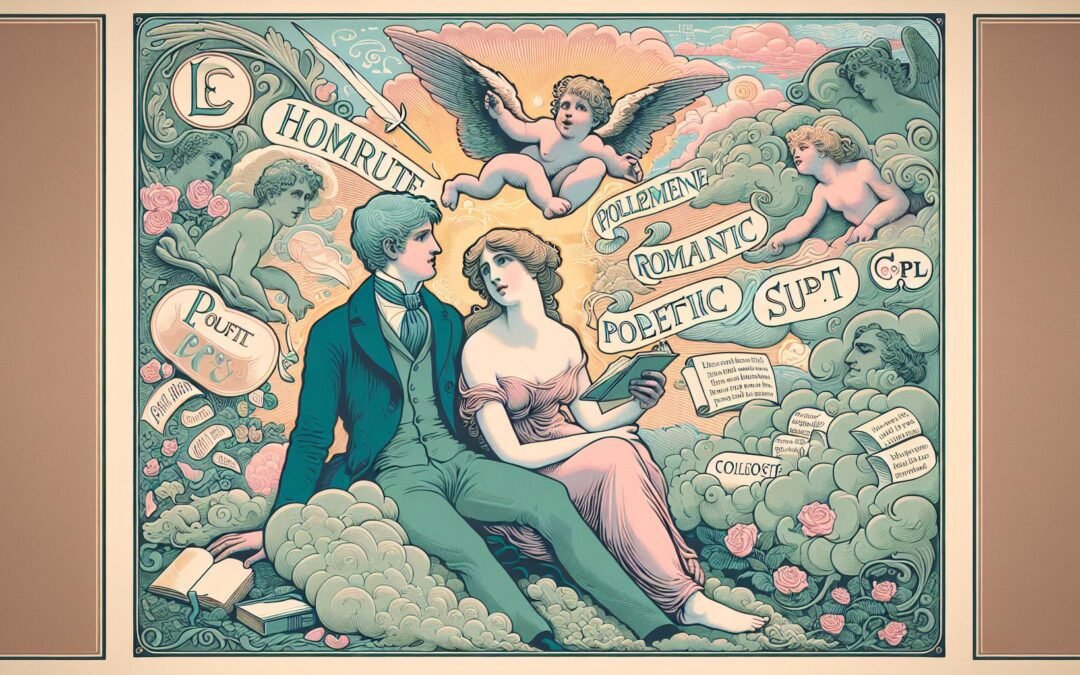Boldly walking the faultline between wit and warmth, funny flirty poems have seduced generations of readers and listeners across disparate cultures. These poems stand apart from overtly earnest or solemn verse, preferring the glancing touch of humor and irreverence to the straightforward declarations favored in traditional rhyming poetry about love. Rather than indulging in grand cliches or confessional yearning, these compositions thrive on brevity, double meanings, and clever subtext that reward both the performer and the audience. Playful language—puns, colloquialisms, and sly contemporary references—signals the intent to delight rather than dominate. Interplay with the reader or listener transforms the poem into a partnership, inviting delight in the joke and the audacity of the approach. Humor serves as defense against awkwardness, a test of shared intelligence, and an accelerant for genuine affection diluted of pretense. The best contributions to this genre wink knowingly at tradition, subverting or remixing it in ways that feel fresh even on the tenth reading.
Origins and Evolution of Funny Flirty Poems
Flirtatious and comic elements surfaced early in literary tradition. Martial’s pointed brevity in ancient Rome, Ovid’s self-parody, and Sappho’s covertly teasing fragments in archaic Greece foregrounded the capacity of verse to imbue attraction with lively wit. Epigrams and comedic monologues—public performance pieces as much as literary texts—functioned as both entertainment and coded courtship. By the medieval period, troubadours across Occitania elevated byplay in song and poetry, embedding mockery and playful exaggeration under the guise of chivalry. Goliardic poets, brazen in their satirical jabs at authority, stretched the possibilities further—transforming social critique and amorous overtures into intertwined pursuits.
Renaissance writers advanced these experiments with linguistic bravura. Shakespeare’s comedies and sonnets interlace flirtation with pointed banter and sexual wordplay, while metaphysical poets challenged expectation with tangled conceits and abrupt wit. The Restoration period, led by the caustic pen of Rochester and Aphra Behn, veered towards explicit gamesmanship, incorporating ribaldry as a means to flip established power dynamics. Enlightenment writers practiced an urbane, almost surgical wit—a style embodied by Lady Mary Wortley Montagu and Alexander Pope—expanding the possibilities of form while threading satire through poetic flirtation. Victorian decorum forced these impulses underground; writers like Edward Lear and Lewis Carroll disguised innuendo within nonsense forms, preserving the genre beneath the surface of respectability. Key twentieth-century innovators, including Dorothy Parker and Wendy Cope, deployed humor as a means to challenge stereotypes and lampoon social expectations, broadening the emotional and stylistic vocabulary of the form. The poetic meme culture of today drove funny flirty poems into the digital age, where their rapidfire delivery and responsiveness have produced new genres and visibility.
Techniques and Craft in Comic Flirtation
Comic seduction in poetry arises from audacious manipulation of language. Double entendre provides a crucial tool: a single phrase unfolds into two or three interpretations, rewarding the attentive with multiple layers of amusement. Puns—especially homophones and semantic ambiguity—deliver surprise, allowing the reader to become co-author of interpretive play. Innuendo shapes anticipation, prompts nervous laughter, and probes social boundaries without vulgarity. Rhyme and meter become tactical allies. Limericks—carefully structured for mock surprise—have been repurposed since Edward Lear’s day for clandestine messages and parodies of romantic tradition, as explored in classic rhyming love poems. Sonnets and heroic couplets, when harnessed for misdirection or subversive humor, draw energy from the clash between elevated form and playful content.
Irony threads through much of the genre. Where conventional romantic poetry valorizes sincerity, comic flirtation constructs a distance between surface and intention, making awareness of performance an explicit part of the interaction. Parody co-opts canonical works—Shakespeare, Donne, or even modern lyricists—turning their tropes inside out. This reimagining becomes a mode of subverting tradition and cultural authority. Fresh metaphors and irreverent imagery (a lover compared to a snack food, a rendezvous likened to a circus act) puncture the grandiosity of love’s language. Vivid sensory or everyday comparisons evoke laughter and recognition, fostering intimacy through fun. Rhythm and pacing mirror conversational agility: enjambment and caesura generate hesitations and reconsiderations, multiplying the possible readings. The dynamic is as much about timing as word choice, with form amplifying or undermining expectations.
Intertextuality is frequently a mark of mastery within funny flirty verse. Referencing classic love poetry, pop culture, or well-worn clichés, poets embed inside jokes and allusions that confer insider status. Archaic diction in a contemporary context, or the reverse, ruptures time and invites novelty. By harnessing and mixing forms—villanelle, ballad, ghazal, haiku—the poet celebrates and lampoons structure simultaneously. Those curious about varied forms may find deeper exploration in collections of ghazals and other global traditions. The genre succeeds where the surface of playfulness cloaks technical sophistication and a sharp eye for emotional currents.
Functions and Social Impact
Funny flirty poems perform social work beyond mere amusement. Used as trial balloons in courtship, these verses rehearse vulnerability and boldness without the risks attached to blunt confession. Humor—by lowering defenses—enables an honest exchange precisely because it protects against the sting of no. It allows both performer and listener to judge mutual interest, sense of humor, and boundaries in real time. In flirtatious contests and poetic games, the audience’s laughter becomes a signal of group acceptance, social permission, or competitive success.
Comic flirtation also challenges the status quo. By poking holes in prescribed gender expectations, questioning romantic ideals, or inverting the traditional pursuer and pursued, it invites renegotiation of relational scripts. Playful exaggeration or overt self-deprecation destabilizes hierarchies, providing license to critique the serious in the guise of jest. Especially where direct conversation feels risky or restricted, the poem becomes an alternative script—one which can disguise, but also reveal, subversive ambition. The genre empowered generations of poets to nudge norms in new directions, sometimes drawing censure but more often securing a wink and complicity from those attuned to its double signals.
Community and memory are built around the exchange and performance of these works. Shared laughter forges bonds, constructs inside jokes, and creates an enduring shorthand for desire, challenge, or reconciliation. Games and poetic duels, from the medieval love courts to contemporary gatherings and online forums, animate a collective spirit, tuning individuals to the rhythms and risks of playful affection. For guidance in crafting fresh compositions, resources on how to write love poetry give aspiring poets genre-specific advice—because a deftly turned phrase can live long after the moment passes.
Global Variations and Cultural Nuance
A cross-cultural lens reveals remarkable diversity and continuity in the terrain of funny flirty poems. The Persian ghazal, for instance, revels in layers of suggestion and longing—mixing the sacred and the profane in ways that require readers to navigate shifting tones and allegiances. Wordplay and ambiguity serve as primary engines for flirtation; the addressee might be divine, beloved, or a rival, and the thrill lies in never declaring the boundary outright. Classical Arabic poetry showcases similar agility, with poets like Abu Nuwas delighting in scandalous reversals and raucous fun. In the Chinese tradition, the ci and shi forms, especially during the Song dynasty, embedded teasing, lyric address, and comic twists into imagined rendezvous and witty correspondence, making playfulness an accepted vehicle for longing.
Japanese tanka and haiku treat brevity as invitation, encoding playful seduction in fleeting vistas or serene images pregnant with subtext. In India, Sanskrit and Urdu verse—especially the shringara rasa tradition—explores romantic banter through metaphorical landscapes and clever duplicity. African oral poetry, notably in Yoruba and Swahili genres, integrates wit, innuendo, and communal participation, drawing laughter and admiration through call-and-response riddles or improvised song. European courts cross-pollinated these approaches, giving rise to the playful skirmishes found in troubadour poetry and Elizabethan lyric. Today, online platforms flatten these distinctions: memes, social media micro-poems, and viral challenges carry forward the spirit of flirty, funny verse—offering global audiences a piece of the joke. For those intrigued by historical and modern crossovers, collections of love poetry reveal contemporary works standing in dialogue with centuries-old traditions.

